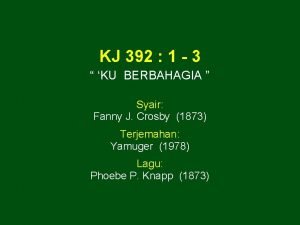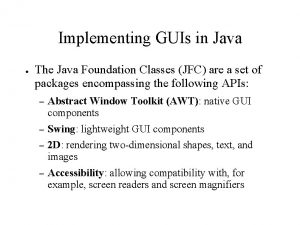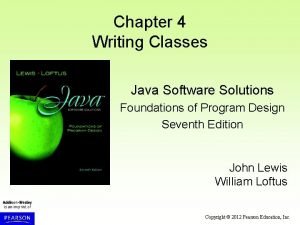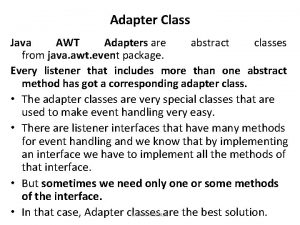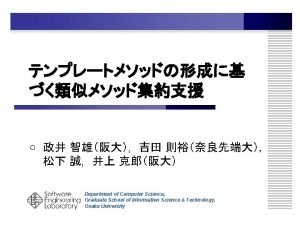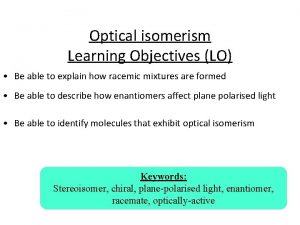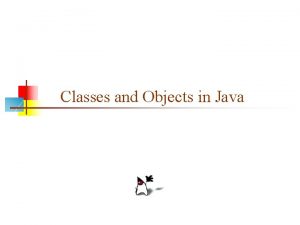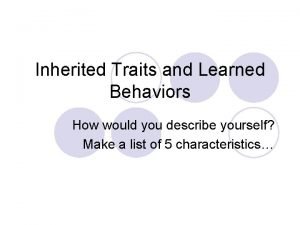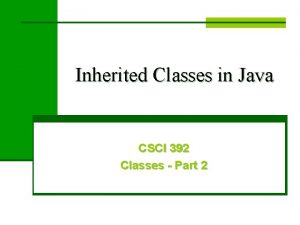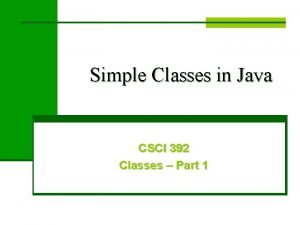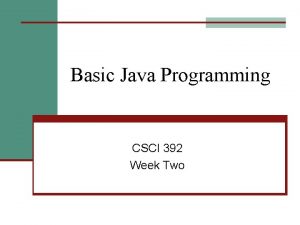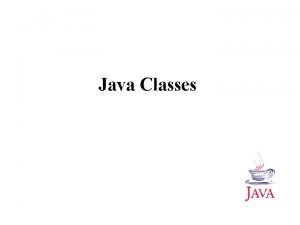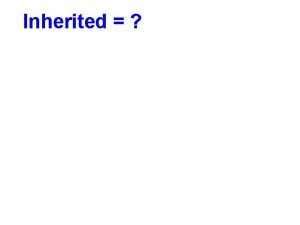Inherited Classes in Java CSCI 392 Ch 6






![public class list { protected int[] values; private int size; . . . public public class list { protected int[] values; private int size; . . . public](https://slidetodoc.com/presentation_image_h2/679ed0d6f56f6a944c0deafdbf90bd28/image-7.jpg)






- Slides: 13

Inherited Classes in Java CSCI 392 Ch 6 in O’Reilly Adapted from Dannelly

Recap from last week… n Scope of Fields and Methods can be n public, private, protected, … n Constructors n syntax is just like C++ n optional since fields can be initialized n "static" fields and methods belong to the entire class, not individual instances

What is Inheritance? n Building a new class by reusing everything in an existing class. n Subclasses can add to methods and fields of their base class, and can replace inherited methods. Animal Fish Mammal

Why use Inheritance? n Reuse existing code n Better Maintenance: Correcting/Improving code in the base class fixes all the subclasses.

Declaring an Inherited Class public class stack extends list { The new stack class is a subclass of the list class

What gets Inherited? n All fields marked as "protected" or "public". n "private" fields are only visible to the class that declared them n "protected" fields are only visible to the class that declared them, and any subclasses n All public and protected methods.
![public class list protected int values private int size public public class list { protected int[] values; private int size; . . . public](https://slidetodoc.com/presentation_image_h2/679ed0d6f56f6a944c0deafdbf90bd28/image-7.jpg)
public class list { protected int[] values; private int size; . . . public class stack extends list {. . . public void some_method () { values[i] = myinteger; // legal size++; // illegal

Overload vs Override Alert n Overloading n creating multiple methods with the same n example: multiple constructors may have the same name if they have different parameters n Overriding n replacing inherited methods n example: see next page

public class Super. Class { public void method 1 () {. . . } public void method 1 (int param 1) {. . . } public void method 2 () {. . . } } public class Sub. Class extends Super. Class { public void method 1 () {. . . } public void method 2 (int param 2) {. . . } }

public class Super. Class { public void method 1 () {. . . } public void method 1 (int param 1) {. . . } public void method 2 () {. . . } } public class Sub. Class extends Super. Class { public void method 1 () {. . . } public void method 2 (int param 2) {. . . } } Override Overload

public class Super. Class { public void method 1 () {. . . } public void method 1 (int param 1) {. . . } public void method 2 () {. . . } } public class Sub. Class extends Super. Class { public void method 1 () {. . . } public void method 2 (int param 2) {. . . } }. . . Sub. Class bob = new Sub. Class(); bob. method 1(); bob. method 2(); bob. method 1(99);

Using the Parent's Constructor/Method public class Parent. Class { public Parent. Class (int param) { do your initializations } public class Child. Class extends Parent. Class { public Child. Class (int param) { super (param); super. method. Name(argument. List); }

Java hierarchy n The Java API uses inheritance extensively in its own classes. n The Object class in the java. lang package is the superclass for all classes. n Common methods of the Object class get. Class() Returns a Class object that represents the type of this object. 1/10/2022 Murach’s Java SE 6,
 Not lagu ku berbahagia
Not lagu ku berbahagia Włącz czynnik pod znak pierwiastka
Włącz czynnik pod znak pierwiastka Class e subclasse
Class e subclasse Pre ap classes vs regular classes
Pre ap classes vs regular classes List button
List button Writing classes java
Writing classes java Mouse adapter class in java
Mouse adapter class in java Abstract classes
Abstract classes Optical isomerism
Optical isomerism Java script classes
Java script classes Interfaces
Interfaces What inherited traits do elephants have
What inherited traits do elephants have Hydrops fetalis
Hydrops fetalis Inherited behavior examples
Inherited behavior examples
